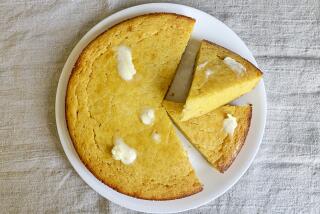GOOD FOOD : Dining With the Kernel
- Share via
Benjamin Franklin is probably best known for his wit, philosophical writings and interest in science--the famous kite with the pendant key flew on June 15, 1752--but among gastronomes he’s known for his passionate words in praise of corn.
These were written in England, in 1765, in response to an anonymous, highly derogatory letter published in a London newspaper, and the truth is that both attack and defense were parts of a political debate, not a culinary clash. Yet Franklin’s statement was so eloquent that corn lovers have been quoting it for their own purposes ever since:
“Pray, let me, an American, inform the gentleman, who seems ignorant of the matter, that Indian corn, take it for all in all, is one of the most agreeable and wholesome grains in the world; that its green leaves roasted are a delicacy beyond expression; that samp, hominy, succotash, and nokehock, made of it, are so many pleasing varieties; and that jonny or hoecake, hot from the fire, is better than a Yorkshire muffin.”
There have been a lot of kernels through the teeth since those days, corn has changed dramatically and sweet corn most of all. In Franklin’s time, all corn was organic, all cornmeal was stone-ground whole grain, and sweet corn on the cob was green corn--the “green leaves” of the letter, unripe ears of the same type of corn that today is dried and ground for cornmeal. The ancestor of modern sweet corn, a different plant, was known to the Native Americans but not discovered by people of European ancestry until 1799.
For the next 150 years, size, flavor and yield all steadily improved, with a great leap forward in the ‘30s, when hybridizing began. Corn on the cob became not only wonderful but reliable: more productive, more disease-resistant and consistently tastier than ever.
One thing, however, did not change: the directions for cooking. “Put a big pot of water on high heat. When it boils, go out and pick the corn. Run back to the kitchen, removing husks as you go, and place ears in kettle as soon as you get through the door.”
In spite of all their efforts, breeders had been unable to solve the biggest problem with sweet corn: All the sugar still turned almost immediately to starch as soon as the ear left the plant.
Finally, in the late ‘50s, genes that would keep corn sweet long after picking were isolated. First “sugary-enhanced” (se), then “shrunken gene” (s2) varieties appeared on the market. By now almost all the sweet corn grown for long-distance shipping--and more and more of that grown for local consumption as well--is of the latter, “supersweet” type.
So now we have corn that stays sweet for days--even weeks--a mixed blessing, unfortunately. These varieties are all as tough as they are sweet, and the flavor of the grain itself is so faint it’s almost lost. Nevertheless, like Mt. Everest, it’s there-- piles of it in supermarkets from coast to coast, heaps of it at the greengrocers. And while it’s not so great for eating as “green leaves,” it does make a mean fresh corn bread.
Soft and Sweet Fresh Corn Bread is itself quite a hybrid, part corn pudding, part spoon bread, and part the lovely in-between corn bread called ogonsa’ ohon’sta by the Iroquois, who were growing true sweet corn along the banks of the Susquehanna while Ben Franklin practiced New World diplomacy in London. The sweet corn too tough to be good as roasting ears was ground and baked, dusted with cornmeal and wrapped in leaves.
Though this is bready enough to be a good absorber of gravy and light enough to be a vegetable accompaniment, it’s so rich and sweet it’s probably best enjoyed as a light main dish, partnered with something sharp, such as a green salad in vinaigrette or fresh snap beans with lots of lemon.
SOFT AND SWEET FRESH CORN BREAD
Butter
Cornmeal
5 to 5 1/2 cups fresh supersweet-type corn kernels
6 tablespoons instant masa
3 eggs
1 1/4 cups whipping cream
3/4 teaspoon baking powder
1/2 teaspoon salt
Generously butter heavy, shallow 12x8-inch gratin pan or 9-inch iron skillet. Dust with cornmeal.
Using sharp knife and cutting shallowly, slice kernels off cob into deep bowl. Using dull side of knife, scrape vigorously to remove interior material. Kernel tips, corn hearts and bit of juice should end up in bowl, while papery husks of kernels remain on cob.
Grind corn to mush in food processor. Mix in masa. Add eggs and process 30 seconds. Whirl in whipping cream, baking powder and salt, processing just long enough to mix. Turn batter into prepared pan and bake at 350 degrees 50 to 60 minutes, or until top is cracked and lightly browned and wood pick inserted in center emerges clean. Best served warm but not boiling hot. Makes 6 servings.
More to Read
Eat your way across L.A.
Get our weekly Tasting Notes newsletter for reviews, news and more.
You may occasionally receive promotional content from the Los Angeles Times.







